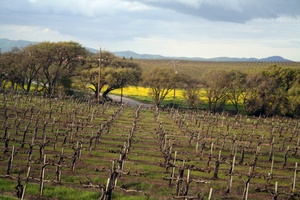Livermore Valley AVA facts for kids
| Wine region | |

Vineyard in Livermore
|
|
| Type | American Viticultural Area |
|---|---|
| Year established | 1982, amended 2006 |
| Country | United States |
| Part of | California, Central Coast AVA, San Francisco Bay AVA |
| Total area | 4,000 Acres of Vineyards |
| Grapes produced | Barbera, Cabernet Franc, Cabernet Sauvignon, Chardonnay, Chenin blanc, Cinsault, Colombard, Counoise, Gewurztraminer, Grenache, Malbec, Merlot, Mourvedre, Muscat Canelli, Nebbiolo, Petit Verdot, Petite Sirah, Pinot blanc, Pinot gris, Pinot noir, Roussanne, Sangiovese, Sauvignon blanc, Semillon, Souzao, Syrah, Tempranillo, Touriga Francesa, Touriga Nacional, Viognier, Zinfandel |
The Livermore Valley AVA is a special area in California where grapes are grown to make wine. AVA stands for American Viticultural Area, which is a fancy way of saying it's a recognized wine region. This area is located in Alameda County, surrounding the city of Livermore. Both the valley and the city get their names from Robert Livermore, an early landowner. The valley also has an important underground water source called the Livermore Basin. This basin helps supply water to many people in the San Francisco Bay Area.
Contents
A Rich History of Wine
People have been growing grapes and making wine in Livermore Valley since the 1800s. One of the first and most famous wineries was Cresta Blanca Winery, started in 1882. Their wine was so good that in 1889, it won a big award in Paris, France! This was the first time a California wine had ever won such a prize in France.
Challenges and Comebacks
However, things changed during the Prohibition in the United States. During this time, it was against the law to make or sell alcohol. Most wineries had to close down. But two wineries in Livermore Valley, Concannon and Wente, managed to stay open. They found ways to continue operating, even during those tough years.
In the early 1960s, Livermore Valley had as many vineyards as Napa Valley. But Napa Valley became much more famous around the world, while Livermore Valley remained a bit of a secret.
Leading Wineries Today
Today, Wente Vineyards is the largest wine producer in Livermore Valley. It was founded in 1883 and is the oldest family-owned winery in the United States that has been running continuously. They make a lot of wine every year and sell it all over the world.
Concannon Vineyard also started in 1883. Their wines are sold across the country. Besides these two big names, there are many other smaller, newer wineries in the valley. Some of these include Steven Kent Winery, McGrail Vineyards, Cuda Ridge Winery, and Ruby Hill Winery.
What Makes Livermore Valley Special?
Livermore Valley has a unique environment that's perfect for growing grapes.
Unique Soil and Climate
The soil in Livermore Valley is mostly made of gravel. This type of soil is great for grapevines. The valley also has a special east-west direction, which is different from many other wine valleys.
A cool breeze blows in from the San Francisco Bay every afternoon and evening. This breeze causes big changes in temperature between day and night. This large temperature swing helps the grapes ripen slowly and develop rich flavors.
Delicious Grape Varieties
Historically, the Petite Sirah grape was known for making some of Livermore's best red wine. The valley's climate is also good for making sweet dessert wines.
Many wineries in Livermore Valley focus on grapes like Cabernet Sauvignon, Merlot, Sangiovese, and Rhone varieties. The first plantings of Sémillon and Sauvignon blanc grapes in the valley came from famous vineyards in France. These grapes still produce excellent wine in the Livermore area today.
Wines made from grapes grown in Livermore Valley can be labeled with different names, or "appellations." These include Livermore Valley AVA, San Francisco Bay AVA, and Central Coast AVA. This tells you where the grapes came from.
Images for kids






